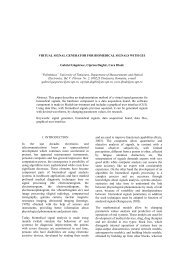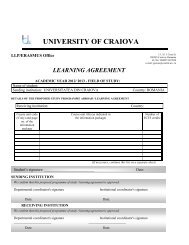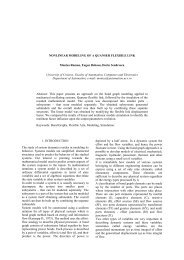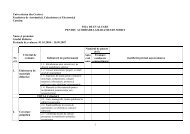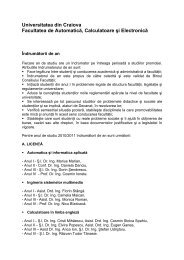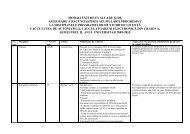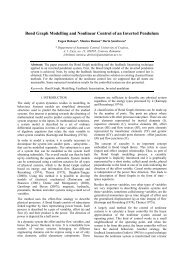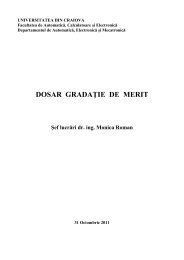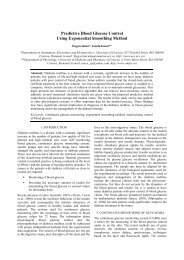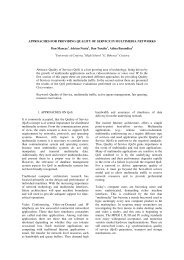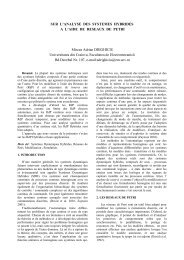the description of a new medical software tool for hospitals ...
the description of a new medical software tool for hospitals ...
the description of a new medical software tool for hospitals ...
You also want an ePaper? Increase the reach of your titles
YUMPU automatically turns print PDFs into web optimized ePapers that Google loves.
THE DESCRIPTION OF A NEW MEDICAL SOFTWARE TOOL FOR HOSPITALSMANAGEMENT AND FINANCEAnca IonLiana StanescuDumitru Dan BurdescuUniversity <strong>of</strong> Craiova, Faculty <strong>of</strong> Automation, Computers and Electronicsanca.ion@s<strong>of</strong>tware.ucv.ro, stanescu@nt.comp-craiova.ro, burdescu@topedge.comAbstract: In this paper we present an efficient and flexible s<strong>of</strong>tware system as an alternative <strong>for</strong> <strong>the</strong>DRG-National application, used by <strong>the</strong> Romanian Government to finance <strong>the</strong> <strong>hospitals</strong>. Thisalternative s<strong>of</strong>tware system is in fact an on-line application based on JSP technology and a MySQLdatabase in order to replace <strong>the</strong> old application realized in MS Access 2000. This application willhelp <strong>the</strong> DRG National Bureau to analyze, at any time, real-time data, and even send it to <strong>the</strong>international organizations. The users can easily get accustom to this <strong>new</strong> application, because itkeeps <strong>the</strong> structure and many menus from <strong>the</strong> old application.Keywords: <strong>medical</strong> applications, management systems1. INTRODUCTIONThe s<strong>of</strong>tware system used <strong>for</strong> <strong>the</strong> managementand finance <strong>of</strong> <strong>the</strong> Romanian <strong>hospitals</strong> permits toclassify <strong>the</strong> patients based on <strong>the</strong> diagnosis, <strong>the</strong>procedures and o<strong>the</strong>r in<strong>for</strong>mation (<strong>the</strong> complexity <strong>of</strong>each case) and to link this type <strong>of</strong> patients that eachhospital treats to <strong>the</strong> expenses needed (DRG, 2005).The necessary data <strong>for</strong> <strong>the</strong> patient classificationon <strong>the</strong> basis <strong>of</strong> <strong>the</strong> diagnosis and <strong>the</strong> procedures in<strong>the</strong>se system categories are: age, sex, hospitalizationperiod, principal diagnosis, secondary diagnosis,procedures, health condition when leaving hospital,<strong>the</strong> birth weight (in <strong>the</strong> <strong>new</strong>-born child case).Through <strong>the</strong> system <strong>of</strong> <strong>the</strong> diagnosis group <strong>the</strong>characteristics <strong>of</strong> each patient who left <strong>the</strong> hospitalare analyzed, and in accordance with <strong>the</strong>se, <strong>the</strong>patients are classified in a different category. Thisway, this system makes an ,,image” to <strong>the</strong> hospitalresults, trying to standardize <strong>the</strong> results <strong>of</strong> thisactivity.The diagnosis groups have two essentialcharacteristics:1) The clinical homogeneity, meaning that in acertain DRG <strong>the</strong> cases (<strong>the</strong> patients) aresimilar from <strong>the</strong> clinical point <strong>of</strong> view, butnot identical2) The costs homogeneity, meaning that eachDRG has cases that need similar usage <strong>of</strong>resources.To be able to classify each patient that left <strong>the</strong>hospital in a diagnosis group <strong>the</strong>re have to be runfour phases:1. <strong>the</strong> disponibility <strong>of</strong> <strong>the</strong> clinical data <strong>for</strong> <strong>the</strong>patients that left <strong>the</strong> hospital2. <strong>the</strong> codification <strong>of</strong> <strong>the</strong> necessary data <strong>for</strong> <strong>the</strong>diagnosis and <strong>the</strong> procedures in order tohave a standardized language <strong>for</strong> <strong>the</strong>sevariables and to be able to use <strong>the</strong>m easily3. ga<strong>the</strong>ring <strong>the</strong>se data in an electronic manner4. <strong>the</strong> automatic classification <strong>of</strong> each patientin a diagnosis groupNowadays, to ga<strong>the</strong>r <strong>the</strong> in<strong>for</strong>mation <strong>for</strong> <strong>the</strong>patients it is used <strong>the</strong> v4.0 application that isdelivered through <strong>the</strong> district agencies (DRG, 2005).This application must be installed on every computerused <strong>for</strong> ga<strong>the</strong>ring data about <strong>the</strong> patients. Theelectronically registration <strong>for</strong> a patient, one <strong>for</strong> <strong>the</strong>whole period <strong>the</strong> patient stays in hospital, is inconcordance with <strong>the</strong> <strong>new</strong> clinical observation <strong>for</strong>m
introduced by <strong>the</strong> Romanian Health and FamilyMinistry. Once collected, <strong>the</strong> data are added to adatabase, which has to be sent monthly to <strong>the</strong> DRGdepartment from <strong>the</strong> National Health Institute <strong>for</strong>Research and Development, Bucharest. This is aRuntime application implemented in Micros<strong>of</strong>tAccess 2000 that collects in<strong>for</strong>mation about <strong>the</strong>patients at <strong>the</strong> department level, encrypt <strong>the</strong>m andafter that send <strong>the</strong>m to <strong>the</strong> DRG National Bureauusing <strong>the</strong> e-mail. The data centralization from alldepartments on a single computer is also possible,where <strong>the</strong> application also has to be installed, andsend <strong>the</strong>m in this centralized manner to <strong>the</strong> DRGNational Bureau.The application has minimal requirements at <strong>the</strong>hardware level and at <strong>the</strong> level <strong>of</strong> <strong>the</strong> Internetconnection.2. THE PRESENTATION OF THE NEWALTERNATIVE FOR THE DRG SOFTWARESYSTEM2.1 Brief comparison <strong>of</strong> <strong>the</strong> two applicationsBecause <strong>of</strong> <strong>the</strong> difficulties presented by <strong>the</strong> DRG-National application, we propose a <strong>new</strong> s<strong>of</strong>twaresystem.The desavantages <strong>of</strong> MS Access 2000 are: it is anadministration system <strong>for</strong> desktop databases andadministrates with efficiency a slightly reducednumber <strong>of</strong> recordings: around 20000-30000 records,generally used in activity management in smallcompanies. That is why, instead <strong>of</strong> using MS Access2000 it is proposed a much stronger system <strong>of</strong>database administration, named MySQL (Welling ,2003).The proposed on-line application <strong>of</strong>fers moreadvantages:- With this solution, <strong>the</strong> encrypt phase <strong>of</strong> dataand <strong>the</strong> transmission through <strong>the</strong> e-mail areeliminated, because it can bring a lot <strong>of</strong>problems; <strong>the</strong> data received by e-mail at <strong>the</strong>DRG National Bureau must be saved in acertain <strong>for</strong>mat, eventually a database, inorder to be consulted ei<strong>the</strong>r withvisualization, or with <strong>the</strong> elaboration <strong>of</strong>some reports, statistics or graphics; whenadding in <strong>the</strong> same database in<strong>for</strong>mationresulted from different sources <strong>the</strong>re mightbe a lot <strong>of</strong> data inconsistencies.- The data that DRG National Bureau sees arealways up to date; it is not necessary to wait<strong>for</strong> <strong>the</strong> end <strong>of</strong> a certain period <strong>of</strong> time toreceive those data.- The application and <strong>the</strong> database servermust be installed on a single computer(server); it will be accessible <strong>for</strong> any user in<strong>the</strong> range <strong>of</strong> his rights from his owncomputer, using a browser; in this manner itis not needed to install <strong>the</strong> application oneach client’s computer; <strong>of</strong> course, <strong>the</strong>server’s per<strong>for</strong>mances must be very high.The application described below is a client/serverapplication implemented using Java technologies(Goodwill,2000) and represents <strong>the</strong> ideal solution toimplement a competitive database with minimumcosts (s<strong>of</strong>tware costs are zero). It is based on aMySQL database server.2.2 The database <strong>description</strong>As we said above, <strong>the</strong> database used <strong>for</strong>implementation is a MySQL database server. Thedatabase structure is <strong>the</strong> following:1. Table tblStatus allows encoding <strong>of</strong> <strong>the</strong>patient status by means <strong>of</strong> two fieldsstatus_id (primary key) and status name.2. For encoding <strong>the</strong> diagnoses <strong>the</strong>re are threetables tblClass, tblSubclass andtblDiagnoses connected by a 1:mrelationship because in one class <strong>the</strong>re areseveral subclasses, and in one subclass<strong>the</strong>re are several diagnoses.3. For encoding <strong>the</strong> XR investigations and <strong>the</strong>functional explorations <strong>the</strong>re is table tblXr,respectively tblInvestFunct4. There is also a table which allows <strong>the</strong>encoding <strong>of</strong> <strong>the</strong> surgical procedures,tblSurgical5. The table tblInt allows encoding <strong>of</strong> <strong>the</strong>different types <strong>of</strong> hospital registrationSome o<strong>the</strong>r tables in <strong>the</strong> database are:6. In <strong>the</strong> table tblHospital <strong>the</strong>re are data about<strong>the</strong> hospital from <strong>the</strong> DRG network:hospital_id (primary key), hospital name,county, city, number <strong>of</strong> beds.7. In <strong>the</strong> table tblDepart <strong>the</strong>re are data about<strong>the</strong> departments from each hospital:department_id ( primary key), departmentname, hospital_id (<strong>for</strong>eign key) used toimplement <strong>the</strong> relationship 1:m between <strong>the</strong>tables tblHospital and tblDepart.8. In every department works a number <strong>of</strong>doctors about whom <strong>the</strong>re are data in <strong>the</strong>table tblDoctor: doctor_id (primary key),name, specialty, department_id (<strong>for</strong>eignkey) used to implement <strong>the</strong> relationship1:m between <strong>the</strong> tables tblDepart andtblDoctor.9. For a certain department and a certaindoctor are registered <strong>the</strong> patients who havea <strong>new</strong> sheet at every hospital record. For<strong>the</strong>ir data a <strong>new</strong> table tblPatient wascreated having <strong>the</strong> following structure:sheet_id (primary key), personal_id, firstname, last name, sex, birth weight in <strong>the</strong><strong>new</strong>-born child case, data <strong>of</strong> registration,data <strong>of</strong> release from <strong>the</strong> hospital, doctor_id(<strong>for</strong>eign key) in order to know <strong>the</strong> doctorwho attended <strong>the</strong> patient, <strong>the</strong> code <strong>of</strong> <strong>the</strong>first principal diagnosis, <strong>the</strong> code <strong>of</strong> <strong>the</strong>
second principal diagnosis, <strong>the</strong> code <strong>of</strong> <strong>the</strong>secondary diagnosis, <strong>the</strong> code <strong>of</strong> <strong>the</strong>hospitalization type, <strong>the</strong> code <strong>of</strong> <strong>the</strong> patientstatus.The database also contains a series <strong>of</strong> tables as<strong>the</strong> result <strong>of</strong> <strong>the</strong> implementation <strong>of</strong> some m:mrelationships between <strong>the</strong> above tables.10. The table tblPatient_XR stores <strong>for</strong> everyobservation sheet identified by sheet_id <strong>the</strong>codes <strong>of</strong> <strong>the</strong> effectuated XR investigations11. The table tblPatient_FuncExpl stores <strong>for</strong>every observation sheet identified bysheet_id <strong>the</strong> codes <strong>of</strong> <strong>the</strong> effectuatedfunctional explorations12. The table tblPatient_Surgical stores <strong>for</strong>every observation sheet identified bysheet_id <strong>the</strong> codes <strong>of</strong> <strong>the</strong> surgicalprocedures made during <strong>the</strong> hospitalizationtimeFig. 1. The user au<strong>the</strong>ntication windowDepending on <strong>the</strong> security level , <strong>the</strong> user will haveaccess to different application modules2.3 Thelevels <strong>of</strong> security and user rightsFor <strong>the</strong> application security some levels <strong>of</strong>security are created.The higher level is <strong>the</strong> zero degree, which is <strong>the</strong>database administrator and he has all <strong>the</strong> rights.For identification a username and a password areused. One <strong>of</strong> its roles is to introduce in <strong>the</strong>tblHospital table a record <strong>for</strong> each hospital added in<strong>the</strong> DRG system.For each hospital a <strong>new</strong> administrator is created,who has all <strong>the</strong> rights over his hospital in<strong>for</strong>mation.This is <strong>the</strong> first level.The administrator from first level has <strong>the</strong>possibility to view all <strong>the</strong> user data(diagnosis andinvestigation tables). Also <strong>the</strong> hospital administratorfrom first level can add a departement record in <strong>the</strong>table tblDepart and one or more users <strong>for</strong> eachdepartment.Aloso he modify <strong>the</strong> department records. The is <strong>the</strong>second level. A user from <strong>the</strong> second level will haveaccess only to <strong>the</strong> in<strong>for</strong>mation from <strong>the</strong> itsdepartment.Fig. 2. One <strong>of</strong> application modules depending on <strong>the</strong>logged userWhen <strong>the</strong> user from zero level have to add a hospitaladministrator, <strong>the</strong> following window will be openedas in <strong>the</strong> bellow figure:2.4 Graphical User InterfaceAt <strong>the</strong> start <strong>of</strong> <strong>the</strong> application <strong>the</strong> user has tointroduce <strong>the</strong> username and <strong>the</strong> password <strong>for</strong> havingaccess to <strong>the</strong> application menu.The interface functions are presented in this paper.The main application window is presented in <strong>the</strong>following figure:Fig. 3. The <strong>for</strong>m by which an adminstrator <strong>of</strong> zerodegree adds a hospital administratorThe roles <strong>of</strong> <strong>the</strong> hospital administator are: creation <strong>of</strong>a <strong>new</strong> department in <strong>the</strong> hospital which headministrates , <strong>the</strong> creation <strong>of</strong> a department user, <strong>the</strong>creation <strong>of</strong> <strong>the</strong> doctors lists <strong>of</strong> <strong>the</strong> department.
Fig. 4. A <strong>for</strong>m which permits to a hospitaladministator to add a department user and <strong>the</strong>doctors’ listThe user from <strong>the</strong> second level (<strong>the</strong> department user)has no access to <strong>the</strong> operations <strong>of</strong> <strong>the</strong> user anddepartment creation. The department user has anoption <strong>for</strong> creating <strong>the</strong> patient sheet(PatientSheet), inwhich he can introduce in<strong>for</strong>mation <strong>of</strong> <strong>the</strong> patientsfrom his department.Fig. 7. The <strong>for</strong>m which permits <strong>the</strong> diverse reportscreation at <strong>the</strong> department, hospital or globallevelThe Report option permits <strong>the</strong> edit <strong>of</strong> diverse reports,ei<strong>the</strong>r at <strong>the</strong> level <strong>of</strong> department or hospital or atglobal level. The access to <strong>the</strong>se reports isdetermined by level <strong>of</strong> security, so that a user from<strong>the</strong> second level has access only to his departmentreports.Fig. 5. The <strong>for</strong>m which allows <strong>the</strong> department user toadd patientsThe department user can introduce specific data <strong>of</strong><strong>the</strong> patient: from general data to diagnosis andprocedures.Also <strong>the</strong> application allows <strong>the</strong> visualization <strong>of</strong> <strong>the</strong>data, depending to <strong>the</strong> logged user. So <strong>the</strong> user canvisualize <strong>the</strong> patients, <strong>the</strong> diagnosis, <strong>the</strong> surgicalprocedures and <strong>the</strong> functional explorations.Fig. 7. The Report windowThe Search option permits <strong>the</strong> searching <strong>of</strong> <strong>the</strong>diagnosis, surgical procedures or functionalexplorations in <strong>the</strong> database. The searching <strong>for</strong>m is<strong>the</strong> same <strong>for</strong> all <strong>the</strong> users.Fig. 8. The searching windowFig. 6. The visualisation <strong>of</strong> <strong>the</strong> data from <strong>the</strong>department or hospital level
CONCLUSIONSThe application described below is a client/serverapplication and represents <strong>the</strong> ideal solution toimplement a competitive database with minimumcosts (s<strong>of</strong>tware costs are zero). It is based on aMySQL database server.This application is an alternative to <strong>the</strong> DRG –National application, which have a lot <strong>of</strong>desavantages.This paper has presented not only <strong>the</strong> drawbacksand <strong>the</strong> inconvenients <strong>of</strong> <strong>the</strong> used application, butalso a <strong>new</strong> solution.The <strong>new</strong> solution is not expensive and <strong>of</strong>fers aseries <strong>of</strong> advantages:- The MySQL database has per<strong>for</strong>mancessuperior to those <strong>of</strong>fered by MS Access- The data viewed by <strong>the</strong> DRG NationalBureau are every moment <strong>the</strong> up-to dateones, without having to wait <strong>for</strong> <strong>the</strong> end <strong>of</strong><strong>the</strong> month- The application and <strong>the</strong> database areinstalled on a single computer, from whereis accessed by everyone who has <strong>the</strong> rights- The administration and <strong>the</strong> security <strong>of</strong> <strong>the</strong>database have been realized by means <strong>of</strong>some security levels and <strong>of</strong> some views on<strong>the</strong> database defined <strong>for</strong> each type <strong>of</strong> userIn <strong>the</strong> end, it has to be mentioned that <strong>the</strong>application is in <strong>the</strong> developing stage.REFERENCESGoodwill J. (2000). Pure JSP, Java Server Pages: ACode-Intensive Premium Reference, SmasDRG Romanian Oficial Page(2005)http://www.d rg.roWelling L, Thomson L. MySQL Tutorial, MySQLPress, 2003



